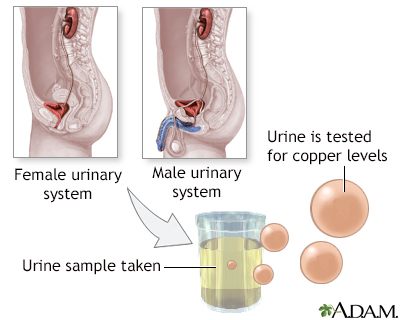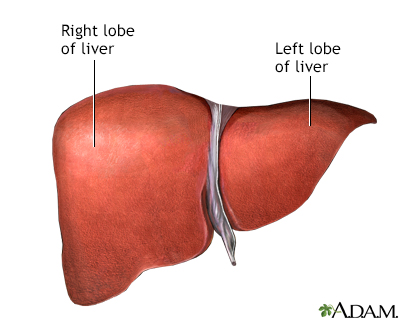Pregnancy SmartSiteTM
Wilson's disease; Hepatolenticular degeneration DefinitionWilson disease is an inherited disorder in which there is too much copper in the body's tissues. The excess copper damages the liver and nervous system. CausesWilson disease is a rare inherited disorder. If both parents carry a defective gene for Wilson disease, there is a 25% chance in each pregnancy that the child will have the disorder. Wilson disease causes the body to take in and keep too much copper. The copper deposits in the liver, brain, kidneys, and eyes. This causes tissue damage, tissue death, and scarring. The affected organs stop working normally. This condition is most common in eastern Europeans, Sicilians, and southern Italians, but it may occur in any group. Wilson disease symptoms typically appears in people under 40 years old. In children, the symptoms begin to show by age 4. SymptomsSymptoms may include:
Exams and TestsA slit-lamp eye exam may show:
A physical exam may show signs of:
Lab tests may include:
If there are liver problems, lab tests may find: Other tests may include:
The gene that causes Wilson disease has been found. It is called ATP7B. DNA testing is available for this gene. Talk to your health care provider or a genetic counselor to learn if you should have gene testing performed. TreatmentThe goal of treatment is to reduce the amount of copper in the tissues. This is done by a procedure called chelation. Certain medicines are given that bind to copper and help remove it through the kidneys or gut. Treatment must be lifelong. The following medicines may be used:
Vitamin E supplements may also be used. Sometimes, medicines that chelate copper (such as penicillamine) can affect the function of the brain and nervous system (neurological function). Other medicines under investigation may bind copper without affecting neurological function. A low-copper diet may also be recommended. Foods to avoid include:
You may want to drink distilled water because some tap water flows through copper pipes. Avoid using copper cooking utensils. Symptoms may be managed with exercise or physical therapy. People who are confused or unable to care for themselves may need special protective measures. A liver transplant may be considered in cases where the liver is severely damaged by the disease. Support GroupsMore information and support for people with Wilson disease and their families can be found at:
Outlook (Prognosis)Lifelong treatment is needed to control Wilson disease. The disorder may cause fatal effects, such as loss of liver function. Copper can have toxic effects on the nervous system. In cases where the disorder is not fatal, symptoms may be disabling. Possible ComplicationsComplications may include:
Liver failure and damage to the central nervous system (brain, spinal cord) are the most common and dangerous effects of the disorder. If the disease is not caught and treated early, it can be fatal. When to Contact a Medical ProfessionalContact your provider if you have symptoms of Wilson disease. Contact a genetic counselor if you have a history of Wilson disease in your family and you are planning to have children. PreventionGenetic counseling is recommended for people with a family history of Wilson disease. ReferencesNational Institute of Diabetes and Digestive and Kidney Diseases website. Wilson disease. www.niddk.nih.gov/health-information/liver-disease/wilson-disease/definition-facts. Updated October 2018. Accessed November 11, 2022. Roberts EA. Wilson disease. In: Feldman M, Friedman LS, Brandt LJ, eds. Sleisenger and Fordtran's Gastrointestinal and Liver Disease. 11th ed. Philadelphia, PA: Elsevier; 2021:chap 76. Schilsky ML. Wilson disease. In: Goldman L, Schafer AI, eds. Goldman-Cecil Medicine. 26th ed. Philadelphia, PA: Elsevier; 2020:chap 200. | |
| |
Review Date: 7/26/2022 Reviewed By: Anna C. Edens Hurst, MD, MS, Associate Professor in Medical Genetics, The University of Alabama at Birmingham, Birmingham, AL. Review provided by VeriMed Healthcare Network. Also reviewed by David C. Dugdale, MD, Medical Director, Brenda Conaway, Editorial Director, and the A.D.A.M. Editorial team. The information provided herein should not be used during any medical emergency or for the diagnosis or treatment of any medical condition. A licensed medical professional should be consulted for diagnosis and treatment of any and all medical conditions. Links to other sites are provided for information only -- they do not constitute endorsements of those other sites. No warranty of any kind, either expressed or implied, is made as to the accuracy, reliability, timeliness, or correctness of any translations made by a third-party service of the information provided herein into any other language. © 1997- A.D.A.M., a business unit of Ebix, Inc. Any duplication or distribution of the information contained herein is strictly prohibited. | |

 Central nervous sy...
Central nervous sy... Copper urine test
Copper urine test Liver anatomy
Liver anatomy
